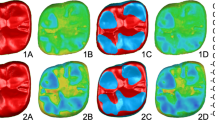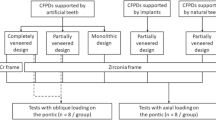Abstract
Objectives
The aim of this study was to evaluate the amount of wear on the antagonist occlusal surfaces of clinically placed monolithic zirconia premolar and molar crowns (LAVA Plus, 3M ESPE).
Materials and methods
Fourteen in situ monolithic zirconia crowns and their opposing antagonists (n = 26) are the subject of an ongoing clinical trial and have been clinically examined at baseline and after 24 months. Silicone impressions were taken and epoxy replicas produced for qualitative SEM analysis and quantitative analysis using optical profilometry. Based on the baseline replicas, the follow-up situation has been scanned and digitally matched with the initial topography in order to calculate the mean volume loss (in mm3) as well as the mean maximum vertical loss (in mm) after 2 years in service.
Results
The mean volume loss for enamel antagonist contacts (n = 7) was measured to 0.361 mm3 and the mean of the maximum vertical loss to 0.204 mm. The mean volume loss for pure ceramic contacts (n = 10) was measured to 0.333 mm3 and the mean of the maximum vertical loss to 0.145 mm. The wear rates on enamel contacts were not significantly different from those measured on ceramic antagonists.
Conclusions
Based on the limitations of this study, it can be concluded for the monolithic zirconia material LAVA Plus that the measured wear rates are in consensus with other in vivo studies on ceramic restorations. Further, that no significant difference was found between natural enamel antagonists and ceramic restorations as antagonists. The monolithic zirconia restorations do not seem to be affected by wear within the first 2 years.
Clinical relevance
The monolithic zirconia crowns (LAVA Plus) show acceptable antagonist wear rates after 2 years in situ, regardless of natural enamel or ceramics as antagonist materials.






Similar content being viewed by others
References
Raigrodski AJ, Hillstead MB, Meng GK, Chung KH (2012) Survival and complications of zirconia-based fixed dental prostheses: a systematic review. J Prosthet Dent 107:170–177
Belli R, Monteiro S Jr, Baratieri LN, Katte H, Petschelt A, Lohbauer U (2012) A photoelastic assessment of residual stresses in zirconia-veneer crowns. J Dent Res 91:316–320
Miyazaki T, Nakamura T, Matsumura H, Ban S, Kobayashi T (2013) Current status of zirconia restoration. J Prosthodont Res 57:236–261
Preis V, Behr M, Handel G, Schneider-Feyrer S, Hahnel S, Rosentritt M (2012) Wear performance of dental ceramics after grinding and polishing treatments. J Mech Behav Biomed Mater 10:13–22
Preis V, Schmalzbauer M, Bougeard D, Schneider-Feyrer S, Rosentritt M (2014) Surface properties of monolithic zirconia after dental adjustment treatments and in vitro wear simulation. J Dent 15:133–139
Esquivel-Upshaw JF, Rose WF Jr, Barrett AA, Oliveira ER, Yang MC, Clark AE, Anusavice KJ (2012) Three years in vivo wear: core-ceramic, veneers, and enamel antagonists. Dent Mater 28:615–621
Silva NR, Thompson VP, Valverde GB, Coelho PG, Powers JM, Farah JW, Esquivel-Upshaw J (2011) Comparative reliability analyses of zirconium oxide and lithium disilicate restorations in vitro and in vivo. J Am Dent Assoc 142(Suppl2):4S–9S
Stober T, Bermejo JL, Rammelsberg P, Schmitter M (2014) Enamel wear caused by monolithic zirconia crowns after 6 month of clinical use. J Oral Rehabil 41:314–322
Mehl A, Gloger W, Kunzelmann KH, Hickel R (1997) A new optical 3-D device for the detection of wear. J Dent Res 76:1799–1807
Anselm Wiskott HW, Perriard J, Scherrer SS, Dieth S, Belser UC (2002) In vivo wear of three types of veneering materials using implant-supported restorations: a method evaluation. Eur J Oral Sci 110:61–67
Heintze SD, Faouzi M, Rousson V, Ozcan M (2012) Correlation of wear in vivo and six laboratory wear methods. Dent Mater 28:961–973
Stober T, Heuschmid N, Zellweger G, Rousson V, Rues S, Heintze SD (2014) Comparability of clinical wear measurements by optical 3D laser scanning in two different centers. Dent Mater 30:499–506
Lee A, He LH, Lyons K, Swain MV (2012) Tooth wear and wear investigations in dentistry. J Oral Rehabil 39:217–225
Etman MK, Woolford M, Dunne S (2008) Quantitative measurement of tooth and ceramic wear: in vivo study. Int J Prosthodont 21:245–252
Lambrechts P, Debels E, Van Landuyt K, Peumans M, Van Meerbeek B (2006) How to simulate wear? Overview of existing methods. Dent Mater 22:693–701
Heintze SD (2006) How to qualify and validate wear simulation devices and methods. Dent Mater 22:712–734
DeLong R (2006) Intra-oral restorative materials wear: rethinking the current approaches: how to measure wear. Dent Mater 22:702–711
Chen YS, Liang WM, Chen FN (2004) Factors affecting the accuracy of elastomeric impression materials. J Dent 32:603–609
Scherrer SS, Quinn JB, Quinn GD, Anselm Wiskott HW (2007) Fractographic ceramic failure analysis using the replica technique. Dent Mater 23:1397–1404
Lohbauer U, Pelka M, Krämer N (2002) Dimensional accuracy of replica die materials. J Dent Res 81(Spec Iss B):359
Internal Report to 3 M ESPE (Data available upon request)
Kramer N, Kunzelmann KH, Taschner M, Mehl A, Garcia-Godoy F, Frankenberger R (2006) Antagonist enamel wears more than ceramic inlays. J Dent Res 85:1097–1100
Author information
Authors and Affiliations
Corresponding author
Ethics declarations
Conflict of interest
The authors declare that they have no conflict of interest.
Funding
The study was financially supported by the 3M Oral Care Company, Seefeld, Germany. Author UL and author SR declare that they have no other financial relationship with 3 M Oral Care.
Ethical approval
All procedures performed in studies involving human participants were in accordance with the ethical standards of the institutional and/or national research committee and with the 1964 Helsinki Declaration and its later amendments or comparable ethical standards.
Informed consent
Informed consent was obtained from all individual participants included in the study.
Rights and permissions
About this article
Cite this article
Lohbauer, U., Reich, S. Antagonist wear of monolithic zirconia crowns after 2 years. Clin Oral Invest 21, 1165–1172 (2017). https://doi.org/10.1007/s00784-016-1872-6
Received:
Accepted:
Published:
Issue Date:
DOI: https://doi.org/10.1007/s00784-016-1872-6




